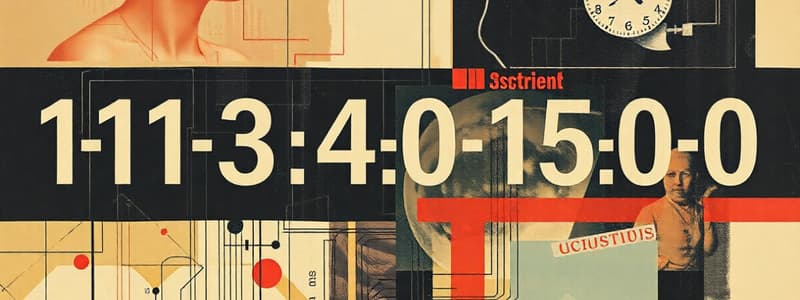Podcast
Questions and Answers
What RISC-V instructions are used for loading bytes and halfwords?
What RISC-V instructions are used for loading bytes and halfwords?
The instructions are lb for loading bytes and lh for loading halfwords.
How does saturation arithmetic differ from two's complement arithmetic?
How does saturation arithmetic differ from two's complement arithmetic?
Saturation arithmetic sets the result to the maximum or minimum value upon overflow, unlike two's complement which wraps around using modulo.
In RISC-V, what instructions are involved in storing the results of byte and halfword arithmetic?
In RISC-V, what instructions are involved in storing the results of byte and halfword arithmetic?
The instructions used are sb for storing bytes and sh for storing halfwords.
What is carry lookahead and why is it important in addition operations?
What is carry lookahead and why is it important in addition operations?
What basic multiplication operations are discussed in relation to understanding more complex operations?
What basic multiplication operations are discussed in relation to understanding more complex operations?
What are the three key terms used in multiplication and their definitions?
What are the three key terms used in multiplication and their definitions?
What is the significance of the number of bits in the product when multiplying two n-bit and m-bit numbers?
What is the significance of the number of bits in the product when multiplying two n-bit and m-bit numbers?
Describe the steps involved when multiplying binary numbers, especially using only digits 0 and 1.
Describe the steps involved when multiplying binary numbers, especially using only digits 0 and 1.
Why is overflow an important consideration in multiplication, particularly for 32-bit numbers?
Why is overflow an important consideration in multiplication, particularly for 32-bit numbers?
What motivations exist for exploring the evolution of multiply hardware and algorithms?
What motivations exist for exploring the evolution of multiply hardware and algorithms?
How does the design of the multiplication hardware resemble the traditional paper-and-pencil method?
How does the design of the multiplication hardware resemble the traditional paper-and-pencil method?
What is the purpose of initializing the 64-bit product register to 0?
What is the purpose of initializing the 64-bit product register to 0?
Why is a 64-bit multiplicand register required for a 32-bit multiplicand?
Why is a 64-bit multiplicand register required for a 32-bit multiplicand?
What are the roles of the ALU in the multiplication hardware?
What are the roles of the ALU in the multiplication hardware?
Explain the shifting mechanism of the multiplicand and multiplier registers during the multiplication process.
Explain the shifting mechanism of the multiplicand and multiplier registers during the multiplication process.
Flashcards are hidden until you start studying
Study Notes
Multiplication
- The process of multiplication involves the multiplicand and the multiplier resulting in the product.
- The multiplication algorithm is similar to the decimal multiplication done using pen and paper.
- The product of an n-bit multiplicand and an m-bit multiplier is n + m bits long.
- Hardware design for multiplication can be implemented by mimicking the traditional pen and paper method.
- The multiplier is stored in a 32-bit register.
- The product register is initialized to 0 and is 64 bits wide.
- The multiplicand is stored in a 64-bit register.
- The product register accumulates partial products.
- The multiplicand is shifted left by one bit in each iteration.
- The multiplier is shifted right by one bit in each iteration.
- The algorithm executes in 32 steps or iterations.
- The multiplier bit (Multiplier 0) determines whether the multiplicand is added to the product register.
- There are several ways to optimize the multiplication algorithm, including:
- Performing parallel shifts (multiplicand and multiplier) while adding the multiplicand to the product.
- Reducing the width of the adder and registers by optimizing the hardware design.
- The performance of multiplication is vital, particularly in contexts where multiplication operations are frequently used.
- The speed of multiplication depends on the number of clock cycles required to complete the process.
- Optimization techniques can reduce the number of clock cycles needed to perform a multiplication operation.
Studying That Suits You
Use AI to generate personalized quizzes and flashcards to suit your learning preferences.




